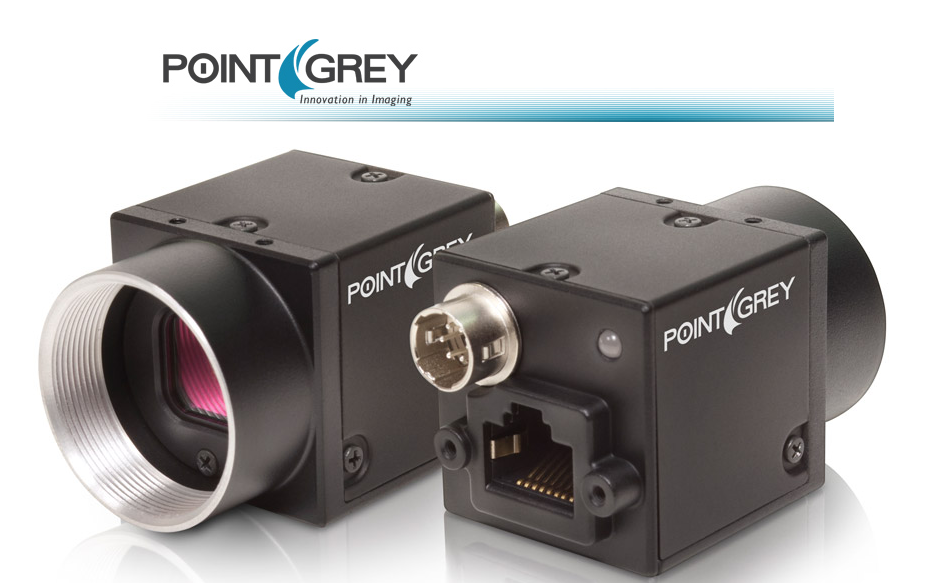PointGrey

Introduction
“Point Grey is a world-leading designer and manufacturer of innovative, high-performance digital cameras for industrial, life science, and traffic applications. We offer a unique and comprehensive portfolio of USB 3.0, GigE, FireWire, USB 2.0 and Camera Link products known for their outstanding quality, ease of use, and unbeatable price-performance.”
The Lima module has been tested only with this GigE cameras models:
Blackfly 1024x768 (model BFLY-PGE-05S2M)
Prerequisite
First, you have to install the PointGrey FlyCapture SDK. We only tested it on debian6 and using the SDK version 2.3.19 (the latest one compatible with debian6 libc).
PointGrey python module need at least the lima core module.
Installation & Module configuration
Follow the generic instructions in Build and Install. If using CMake directly, add the following flag:
-DLIMACAMERA_POINTGREY=true
For the Tango server installation, refers to PyTango Device Server.
Initialisation and Capabilities
Implementing a new plugin for new detector is driven by the LIMA framework but the developer has some freedoms to choose which standard and specific features will be made available. This section is supposed to give you good knowledge regarding camera features within the LIMA framework.
Camera initialisation
The camera has to be initialized using the PointGreyCamera class. The default constructor needs at least the serial number of your camera in order to get the network connection setting up.
In Addition one can provide both packate_size and packet_delay parameters. By default no value is passed.
Std capabilities
This plugin has been implemented in respect of the mandatory capabilites but with some limitations which are due to the camera and SDK features. We only provide here extra information for a better understanding of the capabilities for Andor cameras.
HwDetInfo
getPixelSize(): the method just returns -1, it has to be implemented in further version. get/setImageType(): the plugin only supports Bpp8 and Bpp16
HwSync
get/setTriggerMode(): Depending of the camera model, but some can not support any trigger mode. Otherwise the only implemented modes are IntTrig and ExtTrigSingle. IntTrigMult is normally a mandatory mode (for any camera) and will be implemented in next version.
Optional capabilities
None has been implemented for this camera plugin.
Specific control parameters
Some specific paramaters are available within the camera hardware interface. Those parameters should be used carefully and one should refer to the camera SDK (or user’s guide) documentation for a better understanding.
get/setPacketSize()
get/setPacketDelay()
get/setGain()
get/setAutoGain()
getGainRange()
The following parameters can break the synchronisation with the LIMA HwSync layer by changing the camera internal exposure time.
get/setAutoExpTime()
get/setFrameRate()
get/setAutoFrameRate()
Network Configuration
Depending on your network infrastructure you will need to configure a fix IP address for the camera or use a DHCP setup instead.
The linux SDK provides a configuation tool called
GiGEConfigCmd. The Windows SDK version provides a graphical tool,GigEConfigurator.exe.Then in the PointGrey Tango device set the property
camera_serialusing the camera serial number (sticked on the camera).If you are running the server with linux kernel >= 2.6.13, you should add this line into
etc/security/limits.conf. With the following line, the acquisition thread will be in real time mode:USER_RUNNING_DEVICE_SERVER - rtprio 99
How to use
This is a python code example for a simple test:
from Lima import PointGrey
from lima import Core
cam = PointGrey.Camera(13125072)
hwint = PointGrey.Interface(cam)
control = Core.control(hwint)
acq = control.acquisition()
# configure some hw parameters
hwint.setAutoGain(True)
# setting new file parameters and autosaving mode
saving=control.saving()
pars=saving.getParameters()
pars.directory='/buffer/lcb18012/opisg/test_lima'
pars.prefix='test1_'
pars.suffix='.edf'
pars.fileFormat=Core.CtSaving.EDF
pars.savingMode=Core.CtSaving.AutoFrame
saving.setParameters(pars)
# now ask for 10ms sec. exposure and 100 frames
acq.setAcqExpoTime(0.01)
acq.setNbImages(100)
control.prepareAcq()
control.startAcq()
# wait for last image (#99) ready
lastimg = control.getStatus().ImageCounters.LastImageReady
while lastimg !=99:
time.sleep(.01)
lastimg = control.getStatus().ImageCounters.LastImageReady
# read the first image
im0 = control.ReadImage(0)